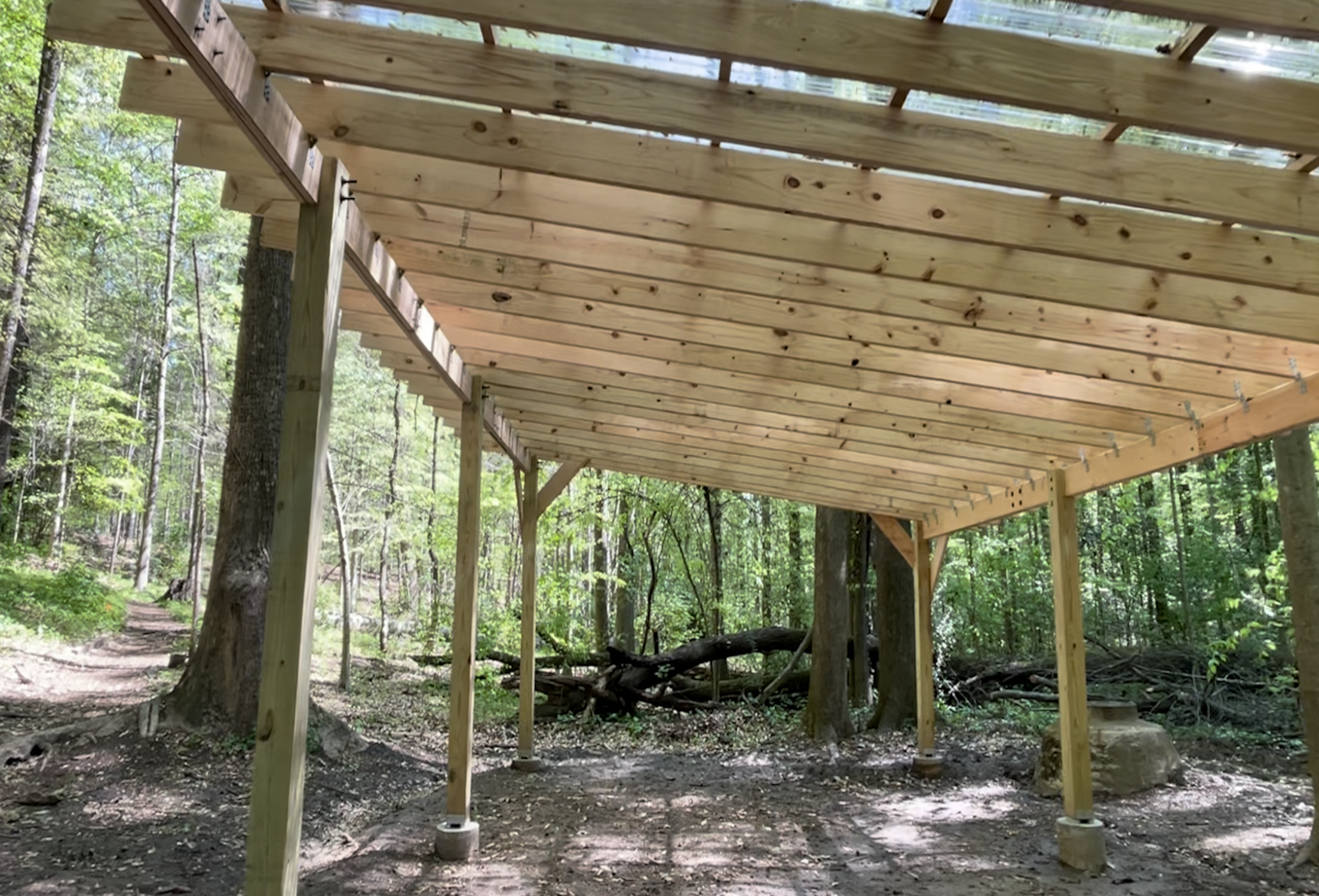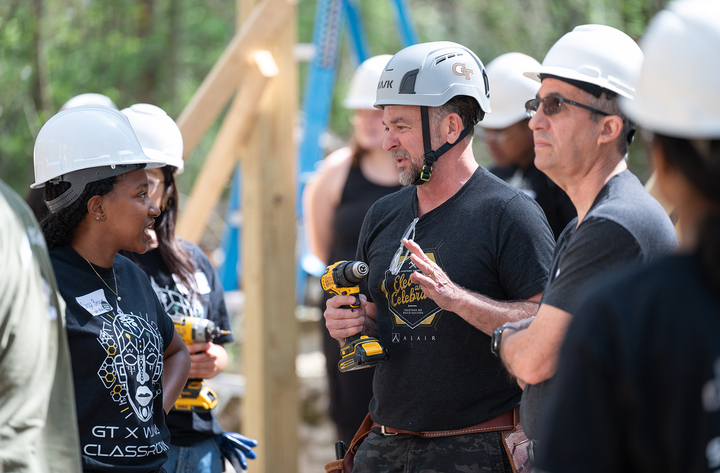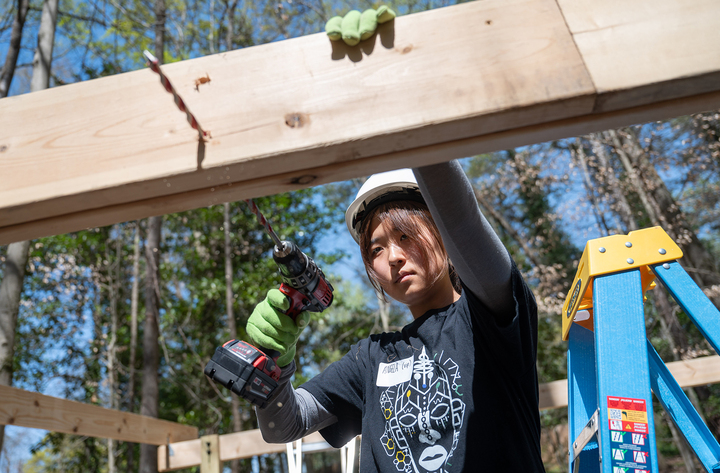Students Build Outdoor Classroom to Serve Community and Nature
In the old-growth forest that joins Atlanta’s Bush Mountain and Oakland City neighborhoods, Georgia Tech students led the build of an outdoor classroom to celebrate nature and community.
A collaboration between Georgia Tech and the West Atlanta Watershed Alliance (WAWA), the classroom is located at the Outdoor Activity Center campus, a City of Atlanta public park and 22-acre nature preserve managed by WAWA.
The classroom will especially serve one of WAWA’s many missions: educating young people and elders alike on the importance of protecting the environment. But equally, it will be a welcoming place for anyone who wants to take in nature.
“I think people take great pride in being stewards of this land,” said Janice Kim, a third-year architecture student and one of the classroom project managers. “The idea of the classroom is that if more people learn about the forest and take ownership in it, they will be more willing to take care of it and it will be here in the future.”
The classroom was constructed as part of a Vertically Integrated Project (VIP), one of Georgia Tech’s intensive, long-term undergraduate research courses. The class, Building for Equity and Sustainability, draws on design principles and values from Georgia Tech’s Kendeda Building, also known as a “living building.” Jennifer Hirsch, senior director of Georgia Tech’s Center for Sustainable Communities Research and Education (SCoRE) and adjunct faculty member in the School of City and Regional Planning, co-led the course with Juan Archila, director of academic and research facilities infrastructure. Jimmy Mitchell, a Tech alumnus who served as project manager for The Kendeda Building, co-founded the VIP with Hirsch and Archila.
WAWA is a long-term partner of SCoRE (previously the Center for Serve-Learn-Sustain), and Hirsch approached them in 2022 to see if they would be interested in establishing a connection with The Kendeda Building.
“WAWA told us they wanted a community-driven outdoor classroom that could seed living building principles into the community,” Hirsch said. “In designing and planning the project, our students had to ask themselves, ‘What does that mean?’ Part of the work for the students was understanding WAWA’s goals as an organization, its history, how it’s related to the community, and where it exists.”


A Sustainable Space for the Community
WAWA stewards the nature preserve and 2 miles of trails within it. The nonprofit also works to protect, preserve, and restore the surrounding neighborhoods’ natural resources, including the Utoy Creek, Sandy Creek, and Proctor Creek watersheds. Their overarching mission is to improve the quality of life within the West Atlanta watershed — for its people and its ecosystem.
“At WAWA, we like to say that everything happens in the watershed,” said Janelle Wright, the nonprofit’s environmental justice programs manager and an alumna of Georgia Tech’s city and regional planning program.
“We have youth and adult camps year-round where we teach environmental mitigation tools for people who want to do more for their community and the watershed,” she said. “This project specifically benefits the environmental education team and the youth component, but also folks who live in the neighborhood and use the space.”
Brian Roberts, a third-year architecture student and the project’s construction lead, played a pivotal role in translating WAWA’s vision and needs into the final project. He and his fellow students attended meetings with WAWA staff and community members to make sure the design aligned with their values.
“Sustainability is a strong principle for our project, but even deeper than that is community engagement, which is a key part of sustainability,” Roberts said. “What’s most important to us is making sure we understand what the community wants and needs. That way, we can build something that is sustainable and serves current and future generations because it is suited to that community.”
Design and planning for the classroom started in 2022, with new and returning students joining every semester since. Over several weekends this spring, students, faculty, alumni, and community members built the classroom with their own hands. Students raised $13,000 to fund the project, coordinated community build days, and sourced sustainable building materials.
Georgia Tech College of Design faculty also made significant contributions to the project. Christian Coles, lecturer in the School of Architecture, consulted with students on how to incorporate Afrofuturist elements into the structure’s design and purpose. Frank Wickstead, adjunct professor in the School of Building Construction, joined students on site to advise on the build. Both Coles and Wickstead are Tech alumni.


The Story Continues
Georgia Tech students are working to incorporate WAWA’s origin story and history into the outdoor classroom and its surrounding environment.
A pivotal moment occurred in 1993, when the City of Atlanta planned a sewer treatment facility for the Utoy Watershed, against the wishes of many southwest Atlanta residents. The Environmental Trust, a local environmental group, was instrumental in the sewer project’s cancellation. The Environmental Trust eventually evolved into WAWA.
Students from the VIP’s “placekeeping” sub-team have helped launch an oral history project that park visitors will be able to access via a self-guided tour. Using QR codes on permanent placards throughout the park’s nature trails, visitors will be able to hear community members tell stories about WAWA and the watershed in their own voices.
“In the case of WAWA, I think placekeeping means acknowledging how much history there is, and how many individual passionate people came together to make it all happen,” said Tiger Peng, a fourth-year computer science student and sub-team lead. “In the oral history project, you’ll find stories about the founders of WAWA, the people who live in the neighborhoods, and other stakeholders who acted to help this organization grow into what it is today.”
Georgia Tech students, faculty, and alumni joined WAWA and the Bush Mountain community for a ribbon-cutting ceremony on April 12. Next year’s VIP students will finish creating and installing oral history signage for the trails and Afrofuturism-inspired educational panels for the outdoor classroom.
The most meaningful part of the project for Kim was using her skills and resources as a Georgia Tech student to help WAWA achieve its vision for the classroom.
“Through this project, I learned a lot about the more personal side of what sustainability means, especially in underserved communities,” she said. “An important part of that is considering what the future might look like for everyone, beyond your own scope.”
To learn more about the course and outdoor classroom, visit the VIP project website.

Credits
Story: Catherine Barzler
Video: Steven Gagliano
Photography: Rob Felt, Jennifer Herseim